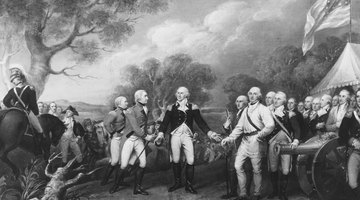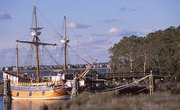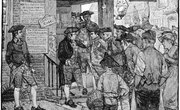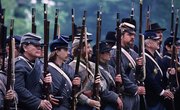When the Revolutionary War began in 1775, the various local militias (and later the new Colonial Army) faced an army that had just won the 18th century version of a world war. British redcoats defeated France in the Seven Years War and were now firmly in possession of India and North America. The British Army was better equipped than that of the colonials and had a long tradition of winning wars.
3,000 Miles of Ocean
However the British had weaknesses that were not apparent at first glance. A chief colonial advantage was the length of the supply lines needed to keep the British in food, ammunition, clothing and replacement soldiers. Generally speaking, British soldiers operating in Europe fed themselves by pooling money and buying food from locals who followed armies for this purpose. But in North America, the population was too sparse for this practice and supplies had to be shipped 3,000 dangerous miles across the Atlantic Ocean. The fact that the British were able to get along as well as they did was a tribute to their ingenuity; but in a war that depended on the British leaving the port cities they held and aggressively pursuing the colonials into the countryside, waiting for logistic resupply made their movements slow and uncertain.
Fighting with Mercenaries
A related weakness for the British was the fact that it was difficult for the government to recruit men into the army, since there was no military draft and few able-bodied British men wanted the hard and dangerous life of the army overseas. In order to fulfill Gen. William Howe’s wish for 50,000 men to defeat the colonials, the British government was forced to turn to German mercenaries from the then-province of Hesse-Cassell (whom the Americans therefore called Hessians). Thirty-thousand British and Hessian troops were in fact sent to North America 1776, but since mercenaries felt no loyalty beyond a pay check, they were prone to desertion.
A Dangerous and Unfamiliar Terrain
Another weakness of the British army was fighting on the unfamiliar wooded and hilly terrain of the American colonies. The British sought flat, open ground so that they could fight in the European style they were accustomed to, with lines of men blasting away at each other with muskets from 50-75 yards. (Although the British had defeated the French in the French and Indian War, their most crucial victory had been at Quebec, on the Plains of Abraham, where the two foes battled as they might have in France). American soldiers were much more willing to fight from concealment and retreat to fight another day, leaving the British, their supply lines growing ever attenuated and more perilous, chasing after them.
A Fighting Rabble
Another weakness of the British, especially at the outset of the war, was its disdain for the colonial fighters it was facing – Burgoyne would famously call the Americans “a rabble in arms" -- and be defeated by them at the battle of Saratoga. (See Reference 4). Gen. Thomas Gage, commanding 2,200 British soldiers at the Battle of Bunker Hill (really Breed’s Hill) in June of 1775, sent his men in frontal charges against this “rabble,” only to see the American stand their ground and kill or wound half of the British forces. Finally, the British faced a failure in coordinating strategic objectives -- their commanders, King George III and his ministers in England, were never quite on the same page as to the best way to defeat the Americans, in part because the same distances that made resupply difficult kept communication uncertain and lacking in timeliness.
Related Articles
References
Writer Bio
Based in New Jersey, Joseph Cummins has been a freelance writer since 2002. He has written 17 books covering history, politics and culture. He has a Master of Fine Arts in writing from Columbia University. His work has been featured in "The New York Times" Freakonomics blog, "Politico," "New York Archives" magazine, "The Carolina Quarterly," "The Michigan Quarterly" and elsewhere.











